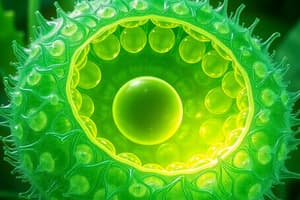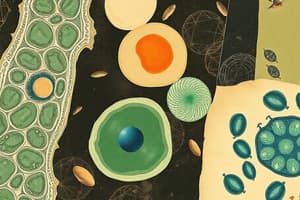Podcast
Questions and Answers
What is the primary function of the middle lamella in plant cells?
What is the primary function of the middle lamella in plant cells?
- To cement the walls of neighboring cells together (correct)
- To allow for cell expansion
- To provide rigidity to the cell
- To serve as a protective barrier against pathogens
Which statement about the primary wall is true?
Which statement about the primary wall is true?
- It is formed after the middle lamella.
- It is more elastic and extendable than the secondary wall. (correct)
- It is composed primarily of lignin.
- It is typically thicker than the secondary wall.
The secondary wall is characterized by which of the following features?
The secondary wall is characterized by which of the following features?
- It is primarily made of lignin and mineral salts. (correct)
- It is usually about 1 - 3μm thick.
- It is laid down outside the primary wall.
- It is mainly composed of cellulose and pectic compounds.
What are the primary components of the primary wall?
What are the primary components of the primary wall?
Which of the following roles does the cell wall NOT perform?
Which of the following roles does the cell wall NOT perform?
Which layer of the cell wall is typically the thickest?
Which layer of the cell wall is typically the thickest?
Flashcards are hidden until you start studying
Study Notes
Cell Wall Structure
- The cell wall consists of three fundamental parts: middle lamella, primary wall, and secondary wall.
Middle Lamella
- The middle lamella cements together the walls of neighboring cells.
- It is usually thin, about 1μm in thickness.
- In woody tissues, the middle lamella is commonly lignified.
Primary Wall
- The primary wall is the first wall formed in a developing cell.
- It is usually 1-3μm in thickness.
- It is more or less elastic and extendable, crystalline, and optically active.
- The primary wall is composed of cellulose, pectic compounds (mostly polysaccharides), and hemicellulose.
Secondary Wall
- The secondary wall develops after the primary wall.
- It is laid down inside the primary wall.
- The secondary wall is about 5-10μm in thickness, more or less rigid, crystalline, and strongly optically active.
- It is mainly composed of lignin, cellulose, non-cellulosic polysaccharides, hemicelluloses, and mineral salts of Ca, Mg, K, and some silica.
Cell Wall Function
- The cell wall forms a framework for the cell to prevent over-expansion.
- Cellulose fibers, structural proteins, and other polysaccharides help maintain the shape and form of the cell.
Studying That Suits You
Use AI to generate personalized quizzes and flashcards to suit your learning preferences.




